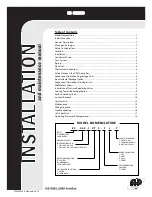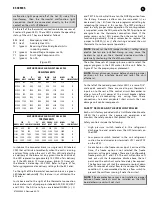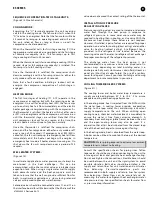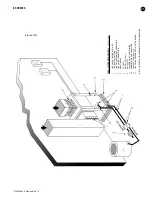
INITIAL INSPECTION:
Be certain to inspect all cartons or crates on each unit as
received at the job site before signing the freight bill. Verify
that all items have been received and that there are no
visible damages; note any shortages or damages on all
copies of the freight bill. In the event of damage or shortage,
remember that the purchaser is responsible for filing the
necessary claims with the carrier. Concealed damages not
discovered until after removing the units from the packaging
must be reported to the carrier within 24 hours of receipt.
GENERAL DESCRIPTION:
These Water-to-Air Heat Pumps provide the best combination
of performance and efficiency available. Safety devices are
built into each unit to provide the maximum system
protection possible when properly installed and maintained.
The ES Water-to-Air Heat Pumps are Underwriters
Laboratories (UL) and (cUL) listed for safety. The water-to-
Air Heat Pumps are designed to operate with entering fluid
temperature between 25°F to 75°F in the heating mode and
between 50°F to 110°F in the cooling mode.
NOTE:
50°F Min. EWT for well water applications with
sufficient water flow to prevent freezing. Antifreeze
solution is required for all closed loop applications. Cooling
Tower/Boiler and Earth Coupled (Geo Thermal) applications
should have sufficient antifreeze solution to protect against
extreme conditions and equipment failure. Frozen water
coils are not covered under warranty.
NOTE:
This product should not be used for temporarily
heating/cooling during construction. Doing so may effect
the units warranty.
MOVING AND STORAGE:
If the equipment is not needed for immediate installation
upon its arrival at the job site, it should be left in its
shipping carton and stored in a clean, dry area. Units must
only be stored or moved in the normal upright position as
indicated by the "UP" arrows on each carton at all times. If
unit stacking is required, stack units as follows: Vertical
units less than 6 tons, no more than two high. Horizontal
units less than 6 tons, no more than three high. "Do not
stack units larger than 6 tons."
SAFETY CONSIDERATIONS:
Installation and servicing of this equipment can be
hazardous due to system pressure and electrical
components. Only trained and qualified personnel should
install, repair, or service the equipment. Untrained
personnel can perform basic functions of maintenance
such as cleaning coils and replacing filters.
WARNING:
Before performing service or maintenance
operations on the system, turn off main power to the unit.
Electrical shock could cause personal injury or death.
When working on equipment, always observe precautions
described in the literature, tags, and labels attached to the
unit. Follow all safety codes. Wear safety glasses and work
gloves. Use a quenching cloth for brazing, and place a fire
extinguisher close to the work area.
LOCATION:
Locate the unit in an indoor area that allows easy removal
of the filter and access panels, and has enough room for
service personnel to perform maintenance or repair.
Provide sufficient room to make fluid, electrical, and duct
connection(s). If the unit is located in a confined space such
as a closet, provisions must be made for return air to freely
enter the space. On horizontal units, allow adequate room
below the unit for a condensate drain trap and do not
locate the unit above supply piping. These units are not
approved for outdoor installation; therefore, they must be
installed inside the structure being conditioned. Do not
locate in areas that are subject to freezing.
INSTALLATION:
NOTE:
Remove all shipping blocks under blower housing.
Loosen compressor mounting bolts.
MOUNTING VERTICAL UNITS:
Vertical units up to six tons are available in left, right, front,
or rear air return configurations. Vertical units should be
mounted level on a vibration absorbing pad slightly larger
than the base to minimize vibration transmission to the
building structure. It is not necessary to anchor the unit to
the floor. (See Figure #1). Vertical units larger than six tons
should be vibration isolated according to the design
engineers specifications.
MOUNTING
HORIZONTAL UNITS:
While horizontal units may
be installed on any level
surface strong enough to
hold their weight, they are
typically suspended above
a ceiling by threaded rods.
The
rods
are
usually
attached
to
the
unit
corners by hanger bracket
kits (P/N 930-004, 006).
(See Figure #2). The rods
must
be
securely
anchored to the ceiling.
Refer to the hanging bracket assembly and installation
instructions for details. Horizontal units installed above the
ceiling must conform to all local codes. An auxiliary drain pan
if required by code, should be at least four inches larger than
the bottom of the heat pump. Plumbing connected to the
heat pump must not come in direct contact with joists,
trusses, walls, etc.
Some
applications
require an attic floor
installation
of
the
horizontal unit. In this
case the unit should be
set in a full size secondary
drain pan on top of a
vibration
absorbing
mesh. The secondary
drain pan prevents
6720220330 Revised 05-12
ES SERIES
(Figure #2)
(Figure #1)
VIBRATION
PAD
FULL SIZE
2
Содержание FHP ES Series
Страница 14: ...6720220330 Revised 05 12 14 ES SERIES Figure 13 ...
Страница 15: ...6720220330 Revised 05 12 15 Figure 14 ES SERIES ...



































